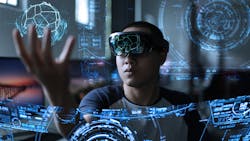While virtual reality (VR) may have been a pipe dream several years ago, it has evolved beyond niche uses and now offers a wide range of practical applications in commercial vehicle maintenance. By generating simulations of three-dimensional environments that users can explore, VR devices and software can assist in everything from remote technician training to real-time vehicle maintenance, ensuring that everyone is on the same page, even if they’re not physically present.
Nowhere is this synchronicity more needed than in vehicle fleet management, in which fleet operators are responsible for managing and maintaining hundreds of connected vehicles. VR can significantly enhance fleet vehicle management and maintenance by providing immersive training, real-time vehicle diagnostics, and opportunities for collaboration among different operational teams. This ultimately leads to more efficient operations, reduced downtime, and a stronger bottom line.
Read more: How AR and VR are used to solve vehicle repair challengesImmersive training
We already know there’s an ongoing and intensifying shortage of maintenance techs across the country. The problem is twofold: vocational programs don’t get the same support as traditional schools and, as vehicles have become more digitized, technicians often need ongoing training to address the increasing complexity of vehicles equipped with software and digital systems.
That technician shortage is pushing automakers and fleet operators towards adopting VR in technician training. This allows them to train more and more people to be able to handle more complicated types of vehicles in a shorter amount of time.
With these programs, students don’t need to be physically in the same place as their instructor. With VR, you can have one instructor teaching multiple students all over the country simultaneously as they livestream in-person demonstrations with accompanying virtual diagrams and notes. Then, the instructor can remotely oversee students’ progress as they perform repairs in virtual reality on virtual vehicles with virtual tools.
Read more: Seeing beyond my hands: Onboarding and training with ARVR systems can also help companies stay technologically up to date and train staff on the latest vehicle models. After all, a technician may have experience repairing autonomous vehicles, but the latest Tesla may add some significant complexities to the task. To address this, companies that purchase a fleet of autonomous vehicles can train staff with VR models of the latest versions of said vehicles.
That level of immersive training is good news for fleet operators, who won’t have to waste time and money finding highly specialized experts to advise their employees. Rather, they can train their own personal arsenal of technicians virtually and keep them up-to-date with the latest vehicle developments.
Remote diagnostics and troubleshooting
Okay, so you can train technicians remotely, but can they perform the work remotely? In some cases, yes. In particular, technicians can diagnose vehicle problems with VR systems and integrated platforms.
With VR, technicians can visualize and analyze data in a 3D virtual representation of the vehicle, which helps technicians identify problems more accurately.
You can even take this one step further. Say you have a vehicle breakdown in a remote area, far from the dispatch center. If there’s no staff technician nearby, you could have someone diagnose the issue using a VR model of the vehicle and then explain to a local mechanic what’s wrong and how to fix it.
It works the other way around, too. When a vehicle breaks down or experiences problems, on-site mechanics can wear VR headsets and receive step-by-step visual instructions for repairs from the system at home base. VR can overlay repair instructions onto the physical vehicle components, guiding mechanics through complex repair processes. This ability saves fleet vehicle operators time and money in the long run by streamlining repairs and getting vehicles back on the road.
Improved collaboration
Another benefit of VR is its ability to improve collaboration among stakeholders. But because VR is available via wildly different softwares and devices, you need an integrated platform that allows people to collaborate and meet remotely. For instance, with VR you might have a fleet vehicle operator, a driver, a mechanic, and an automaker trying to join the same virtual environment, where everyone needs to see the issue in real-time as the mechanic walks through the moving parts or problem. This requires something akin to a VR command center.
Once you’ve established a VR command center, which you can create using a cloud-based VR management service, you can bring together maintenance teams from different locations to discuss complex repairs or even share best practices. Mechanics can collaborate by sharing visualizations of vehicle components and discussing repair strategies.
This collaborative potential goes beyond individual vehicles to understanding the entire operations facility. VR allows stakeholders to virtually visit fleet locations, warehouses, or maintenance facilities without the need for travel. This is particularly useful for suppliers or executives who need to understand on-ground operations. The tech allows third-party partners to collaborate more effectively with fleet operators and deliver services aligned with the workings of the dispatch center.
Virtual reality has the potential to ease hiccups throughout the entire fleet management process: diagnosing vehicle issues, responding to them, and getting everyone on board, literally and figuratively.
Nadva Avni is Chief Marketing Officer for Radix Technologies, which manages and consolidates organization devices, related work processes and stakeholders in one platform.
About the Author

